In order to clean the U.S. power grid, wind, solar and energy storage professionals will need to deploy over a terawatt of additional clean electricity capacity.
No problem, drill sergeant! The developers are at the ready!
According to power plant waiting lists around the country, over half of the generation we need is already in queue. But curb your enthusiasm: the power grid isn’t yet ready to take on these projects, and many of them won’t be built.
What matters most is not the low rate of project completion, but that this emerging data sends the signal that developers have already completed reconnaissance on more than half the sites needed to reach our clean electricity goals.
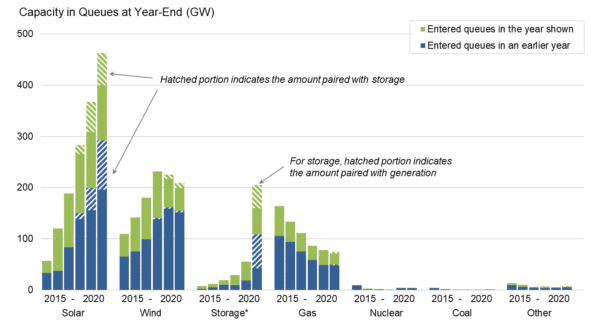
The Department of Energy’s Electricity Markets & Policy Group at Berkeley Lab (EMP) has released new data tools that summarize the proposed projects in the nation’s power grid interconnection queues. The queues represent 85% of the country’s electricity sales.
Included within this release is a data rich interactive tool, a graphic slide deck discussion, and the cumulative queue data itself.
The key data show that we have more than 750 GWac of electricity generation capacity in the queues, and 90% of that is clean energy-related.
More recently, added capacities from renewable electricity sources have completely dominated the queue. The chart below was taken from the interactive data tool. It shows that gas represents the only fossil capacity added since 2016. Solar and solar+battery dominated new capacity in 2020.
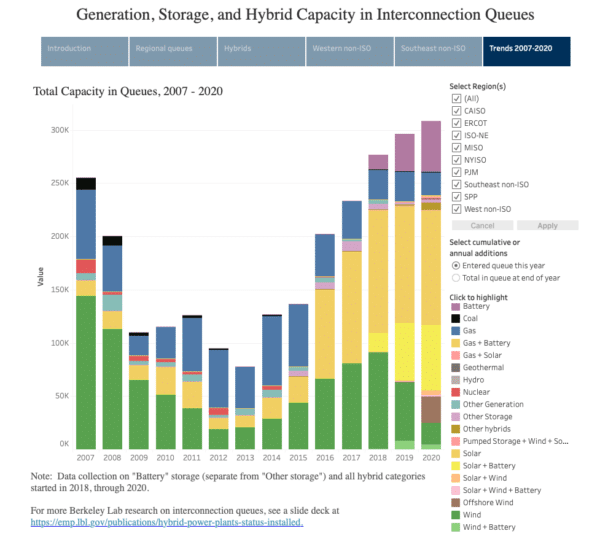
With a total of 462 GWac, solar accounts for the largest share of generator capacity in the queues. Applying the standard 1.25 module-to-inverter ratio results in 577 GWdc of solar capacity. Currently, installed U.S. solar capacity is just over 100 GWdc.
Wind, at 209 GWac, represents the second largest capacity volume in the queue. Offshore wind represents 61 GWac of that amount, having started from almost zero last year.
With both the East and West Coasts embracing offshore wind, and with technological advancements like floating wind, we could hypothetically power the whole of the United States. Expect this capacity to grow massively in future reports.
And while there is no nuclear, coal, or “other” capacity to speak of, there is 74 GWac of natural gas capacity in the queues. pv magazine USA has reported that while substantial volumes of new fossils are built annually, there has been zero net new fossil capacity since the mid 2000’s. New gas capacity primarily replaces dirtier, less flexible, and more expensive coal capacity.
Energy storage volume up 400%
In addition to the generation hardware, the queues now hold greater than 200 GW of energy storage. The capacity value – the number of consecutive hours that 200 GW can be delivered – is not yet publicly available. The greatest number of projects may involve 4-hour batteries, but there are many shapes and sizes in our current market.
The real energy storage story isn’t volume, but rate of growth. At the end of 2019, there were about 50 GW of storage power capacity; by the end of 2020 that number had ballooned 400%.
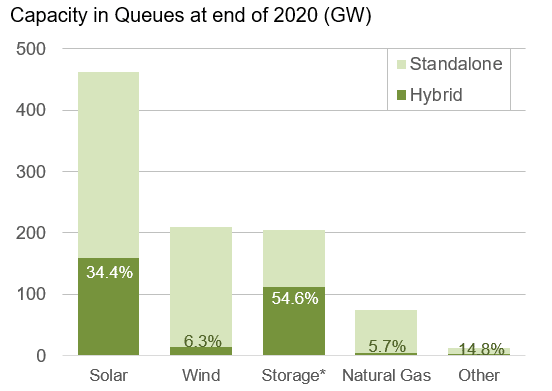
A little over half of all the energy storage capacity is coupled with solar and wind power. A recent analysis by the EMP team suggests that there would be significantly less coupling without the IRS’s Investment Tax Credit, which applies to batteries when they’re paired with solar.
The absolute volume of energy storage in the queue is probably between 400 and 800 GWh. That might seem small compared to our full year electricity use of 4,000,000 GWh. However, that potential 800 GWh provides nearly two of the 12 hours of energy storage that is needed for the U.S. power grid to reach 80% wind plus solar.
Speculation
A key detail of the report is that a large percentage of this volume will not be built. Historically, less than one-quarter of projects that entered the interconnection queues were actually built. According to EMP, that number is even lower for solar and wind power.
One reason for this is that many groups submit projects to the electricity utility when the utility submits a request for proposals (RFP). As a result, these RFPs often become heavily oversubscribed with bids.
And sometimes, as in the case in Texas, there is significant project speculation by those hoping to sell electricity in a nascent solar power market. In fact, the Texas queue for solar power – 64 GW – represents 13% of the nation’s total solar power queue.
Unrecognized capacity
Remember, although we can meet U.S. electricity needs with a 100 km x 100 km square placed out in the desert, we don’t need to. In addition to eye-popping utility scale capacity volumes, we are also seeing significant volumes of solar built on residential and commercial rooftops.
For instance, New York, Pennsylvania, Massachusetts, and Virginia all have solar power programs deploying systems up to 5 MWac. The queue data from EMP shows fewer than a dozen 5 MWac projects in Pennsylvania, while is now at least 1 GW of projects submitted.
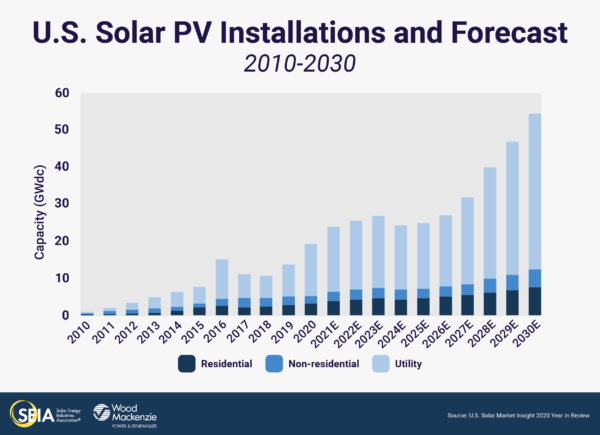
Furthermore, every single year we install a growing volume of residential and nonresidential (commercial) projects. These two segments on their own just broke 5 GWdc for the first time in 2020. Projected out, that would mean adding over 100 GW by 2035.
Meeting Biden’s 2030/2035 goals
Two documents, a 2030 analysis calculating what’s needed to meet our goal of an 80% clean power grid, and the Biden administration’s 2035 goal of a 90% clean power grid – suggest that we need 950 GW and 1,100 GW, respectively, of solar and wind capacity.
The EMP queue volumes today represent 61% and 71%, respectively, of the capacity required to hit those 2030 and 2035 targets. The largest developers know that much of what is in their queue today won’t be built by then; however, there’s a long way to go.
One of the largest solar developers in the U.S., and possibly the largest member of the queue, NextEra has stated in quarterly financial earnings calls that there is much more development capacity potential in its pipeline than the gigawatts disclosed in its quarterly earnings reports. This capacity will be unlocked, the company said, when and if financial and political conditions support it.
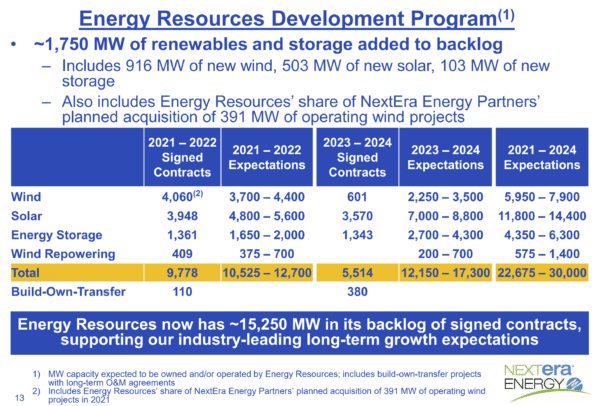
Considering that President Biden announced a federal goal of 100% clean electricity by 2035, along with a clean energy standard, we should expect to see queue numbers continue to grow. If project submission-to-completion rates remain as low as they currently are, then we should expect to see truly massive volumes – terawatt plus – enter the queues.
What actually gets built… well, that’s yet to be determined.
This content is protected by copyright and may not be reused. If you want to cooperate with us and would like to reuse some of our content, please contact: editors@pv-magazine.com.








If you believe in climate change from CO2, then you will build your own off-grid solar system with storage. If you wait for the Government or utilities to build it, you may not see it in your lifetime.
“The real story isn’t volume, but rate of growth”. Brilliant! (no sarcasm). U.S. electric sector carbon declines in 2019 and 2020 are on a straight line path to end in 2026 or 2027. That won’t happen, unless we speed up new efficiency, wind and solar, because almost two thirds of that carbon come from less carbon-intensive natural gas plants. But it is still one indicator that this is happening faster than almost anyone thinks.
This is the first report I’ve seen that puts it in context of the Queue. Even better. The development of massive hydrogen storage and chemical factory projects is being recognized as having a real potential to drive wind and solar, rather than waiting around for the direct use of electricity to leave some tidbits laying on the table during peak sun and wind hours.
And what you do is most important because it highlights the fact that we only need so much, that states and nations which act stupidly will be customers, and not providers, and that there is only so much time left before all of this is a done deal. I’m from Ohio, so I know what I’m talking about, in a state where the majority of elected officials obviously don’t.
Appreciate your comment